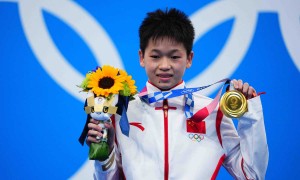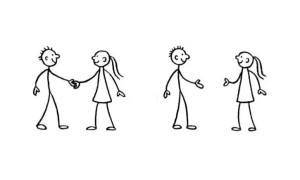要学会新东西,非得失败几回不可。然而,失败多少回才算合适?亚利桑那大学牵头组织研究,最近给出了一个精确答案。
Educators and educational scholars have long recognized that there is something of a “sweet spot” when it comes to learning. That is, we learn best when we are challenged to grasp something just outside the bounds of our existing knowledge. When a challenge is too simple, we don’t learn anything new; likewise, we don’t enhance our knowledge when a challenge is so difficult that we fail entirely or give up.
教育工作者与教育界学者早有共识:学习也讲究“最佳击球点”(高尔夫球、网球等运动中球杆或球拍上的最有效击球点,也称甜点或甜蜜区——本网注)。即在需要掌握刚好超出现有知识面的东西时,学习效果最佳。如果挑战过于轻松,我们就学不到新东西;如果挑战难度过高,我们完全应对不了乃至放弃应对,那就同样无法拓宽知识面。

So where does the sweet spot lie? According to the new study, to be published in the journal Nature Communications, it’s when failure occurs 15% of the time. Put another way, it’s when the right answer is given 85% of the time.
那么,“最佳击球点”究竟在哪里?《自然·通讯》将刊登的最新研究显示,15%的失败率是学习的最优难度。换句话说,能够回答出来的部分应在挑战中占85%的比例。
“These ideas that were out there in the education field – that there is this ‘zone of proximal difficulty,’ in which you ought to be maximizing your learning – we’ve put that on a mathematical footing,” said UArizona assistant professor of psychology and cognitive science Robert Wilson, lead author of the study, titled “The Eighty Five Percent Rule for Optimal Learning.”
这篇研究论文题目为《最优学习方法的八五定律》。论文第一作者、亚利桑那大学心理与认知科学助理教授罗伯特·威尔逊说:“教育界流行观念认为存在‘中等难度区’,在这一区间内学习,效率最高。我们用数学方法进行了验证。”
Wilson and his collaborators at Brown University, the University of California, Los Angeles and Princeton came up with the so-called “85% Rule” after conducting a series of machine-learning experiments in which they taught computers simple tasks, such as classifying different patterns into one of two categories or classifying photographs of handwritten digits as odd versus even numbers, or low versus high numbers.
威尔逊与布朗大学、加利福尼亚大学洛杉矶分校、普林斯顿大学的研究人员合作做了一连串机器学习实验,提出所谓的“八五定律”。他们教计算机完成一些简单任务,例如,把不同的图形分为两类,或者把手写数字的照片按照数字的奇偶或大小加以分类。
The computers learned fastest in situations in which the difficulty was such that they responded with 85% accuracy.
当研究人员设计的难度让计算机回答的准确率为85%时,它们学得最快。
“If you have an error rate of 15% or accuracy of 85%, you are always maximizing your rate of learning in these two-choice tasks,” Wilson said.
威尔逊说:“在二选一这类任务中,错误率为15%或者说准确率为85%时,学习效率就总是达到最高。”
When researchers looked at previous studies of animal learning, they found that the 85% Rule held true in those instances as well, Wilson said.
威尔逊说,他们随后考察了以往的动物学习研究,发现“八五定律”同样适用。
When we think about how humans learn, the 85% Rule would mostly likely apply to perceptual learning, in which we gradually learn through experience and examples, Wilson said. Imagine, for instance,a radiologist learning to tell the difference between images of tumors and non-tumors.
威尔逊说,想想人类的学习特点,通常可能会适用八五定律的大概是知觉学习,它是依靠积累经验和案例的逐步学习。例如,设想放射科医生学习区分肿瘤影像与非肿瘤影像。
“You get better at figuring out there’s a tumor in an image over time, and you need experience and you need examples to get better,” Wilson said. “I can imagine giving easy examples and giving difficult examples and giving intermediate examples. If I give really easy examples, you get 100% right all the time and there’s nothing left to learn. If I give really hard examples, you’ll be 50% correct and still not learning anything new, whereas if I give you something in between, you can be at this sweet spot where you are getting the most information from each particular example.”
威尔逊说:“识别肿瘤影像是一件日积月累、越来越拿手的事情,需要经验,也需要案例。设想有三类案例,分别是简单案例、高难度案例和中等难度案例。假如案例非常简单,你永远全部答对,那就没有什么可学的。假如案例难度极高,你只答对一半,那同样学不到新东西;但如果难度介于两者之间,那你就会处于‘最佳击球点’,从每一个案例中学到的东西最多。”
Since Wilson and his collaborators were looking only at simple tasks in which there was a clear correct and incorrect answer, Wilson won’t go so far as to say that students should aim for a B average in school. However, he does think there might be some lessons for education that are worth further exploration.
由于这次只是研究对错分明的简单任务,威尔逊并不就此认为学生应以平均拿到“良”作为学业目标。不过他确实认为,这项研究对教育或有启发,值得深入探讨。
“If you are taking classes that are too easy and acing them all the time, then you probably aren’t getting as much out of a class as someone who’s struggling but managing to keep up,” he said. “The hope is we can expand this work and start to talk about more complicated forms of learning.”
他说:“如果课程内容过于简单,你总能取得好成绩,那么你在这门课上的收获多半反而不及学业吃力但勉强跟得上的学生。我们希望扩展这项工作,着手研究复杂一些的学习形式。”







